HARE'S EAR PATTERNS
We will be discussing some of the famous Hare's Ear patterns of history along with a selection of various Hare's Ear Patterns that I have used as a Fly Fishing Guide and during the Fly Tying Clinics I have conducted over the past thirty years.
Of course over the time span of 103 years the fly rods, lines and tippets have improved as have the understanding by the fly anglers on how to effectively fish nymph imitations.
Over the years I have conducted a fly tying exercises where I chose a material such as the Hare's Ear Fur and then proceed to see how many different imitations I can construct with this material. Then I have the fun of taking them out and seeing how many of them are effective throughout a fishing season. I have conducted this exercise many times over the years and it has allowed me to gain a better understanding of the material being used, the imitations being tested and of course the fun of catching the trout. Now I am going to list the recipes for some of the historical patterns that were named as Hare's Ear patterns.
The very first of pattern that I encountered in my research that was named Hare's Ear was found in Samuel Taylor's Angling in all its Branches which was published in 1800. This text can be found on-line at:
https://archive.org/details/anglinginallits02taylgoog
The pattern is basically the same pattern that I will later list from the notes of Henry Wade.
The very first series of patterns that I found that were named as Hare's Ear Patterns come from J. Coad who published The Angling Excursions of Gregory Greendrake in 1826. In the text which is available on-line at https://archive.org/search.php?query=The%20Angling%20Excursions%20of%20Gregory%20Greendrake there are eight patterns listed as Hare's Ear patterns. I will list the recipe for one of the patterns listed.
Hare's Ear and Olive
- Body: Hare's Ear Fur
- Ribbed: Cuckoo Hackle
- Wings: Mallard (Flank)
Note: Suggest modern hooks Tiemco 100, furthermore it is speculated that the wings were tied in an upright position.
In today's fly tying world the thread would be selected to match the material used in construction. In 1826 there were few choices and the thread used was either black or white.
The next historical pattern I will list comes from the text of Henry Wade's Halcyon, or Rod Fishing with Fly, Minnow and Worm which was published in 1861. This volume contains a massive list of fly patterns and the text is available on-line. https://archive.org/details/cu31924085660292 and in this text he list the following Hare's Ear pattern.
The Hare's-Ear
- Body: Dark Hare's Ear Fur
- Legs: Red Cock's Hackle
- Wings: Quill Segments from the light coloured starling quill feather
He offers another variation tied on a number two limerick hook using wings from feather of from the wing of a Land-Rail. Furthermore he claimed that this variation was a killing pattern for the months of summer.
Now I am going skip forward to the text of Floating Flies and How to Dress Them, authored by Frederic Halford in 1886. Halford list the Hare's Ear Quill, Hare's Ear and the Gold-Ribbed Hare's of course all of these patterns are presented as dry flies. It is also accepted that Frederic Halford popularized the Gold Ribbed Hare's Ear and it soon was relied on as a "go to dry fly".
I speculate that this popularization of the Gold Ribbed Hare's Ear dry fly caused other angler/tyers to reexamine this material and soon the Gold Ribbed Hare's Ear wet fly began to gain prominence as a "go to wet fly".
https://archive.org/details/floatingflieshow00halfrich
The above link will allow you to view Halfords text on-line if you desire.
Halfords Gold-Ribbed Hare's Ear
- Wings: Medium or Pale Starling
- Body: The body is formed of dark fur from the Hare's Mask
- Rib: Fine flat gold tinsel
- Tails: Red Cock's beard hackle
Notes: Halford suggested this pattern was tied on hook size 0 or 00.
Once Halford popularized this pattern it was seldom off the list of dry flies of the many authors that were to publish in the future even though Halford later discarded the pattern as ineffective.
Now I will move on to some of the more modern patterns which many of you will be familiar with and then I will bore you some of the nymphal patterns that I have played with over a life time of the fly fishing, fly tying and guiding.
Anyway the following is some of the effective patterns I have experimented over the years. Now I am not claiming to have invented any of these patterns for all I am doing is taking the basic Hare's Ear Patterns that have been used down through the passage of time and modified them using different hook styles and mixing the Hare's Ear Fur with various other materials to achieve different looks and pattern styles for the Hare's Ear.
The following patterns are just basic patterns use your own creativeness to create many different and effective patterns for the waters you fish.
Remember Hare's Masks can be dyed in a variety of colors. Plus rabbit skins can be dyed in a variety of colors and can be used as dubbing, cut into strips and used in a variety of ways.
Now any reasonable fly tyer could come up with more than a dozen patterns using Hare's Ear as the main ingredient. However I am not going to bore you with a dozen patterns or even six patterns but will share four patterns with you. Now of course the standard patterns would be the Gold Ribbed Hare's Ear Wet Fly, Nymph or even the Hare's Ear Dun (Standard style) Fly however none of these patterns will be offered as they are easily found in many books on Fly Tying.
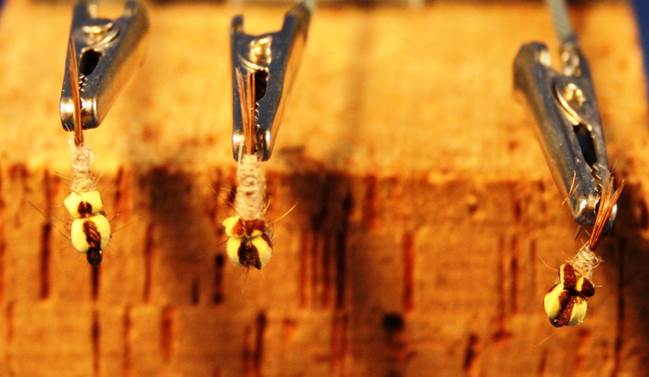
Hare's Ear Floating Nymphs
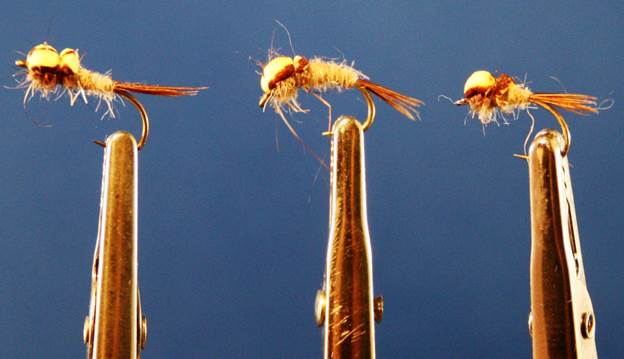
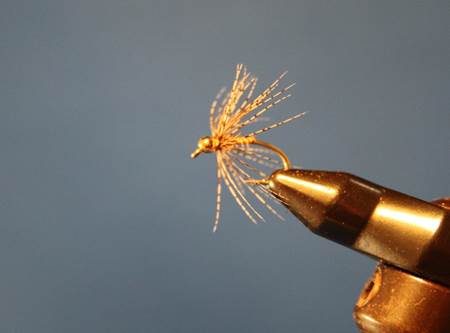
Hare's Ear Bead-head Soft Hackle
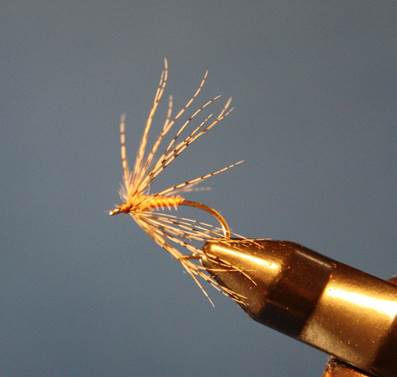
Hare's Ear Soft Hackle on A Dai Riki #125
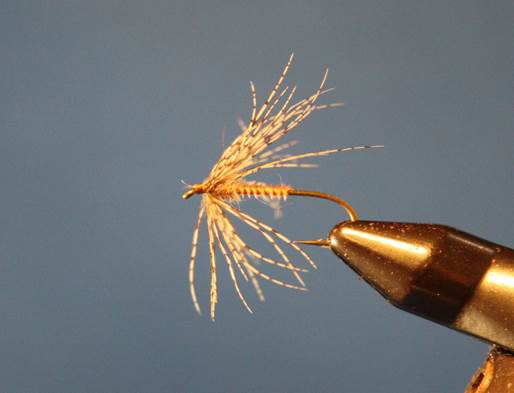
Hare's Ear Soft Hackle on TMC 100
Hare's Ear Soft Hackle
- Hook: TMC 2487, TMC 2457, TMC 100, TMC 101, Dai-Riki 125 Sizes: 10-20
- Thread: 8/0 or 12/0 Camel
- Weight: Optional Bead (Mental, Tungsten or Plastic) as desired or a wraps of non-toxic lead wire as desired
- Abdomen: Dubbed Hare Ear Fur or Dark Tan Turkey Biot, begin the body forward of the hook point
- Thorax: Dubbed Hare's Mask Fur
- Hackle: Natural back feather Hungarian Partridge, brownish
As with all of the patterns you can mix and matched the colors to match the naturals you are seeing, don't be confined by rules. The rules of others will stifle your creative process.
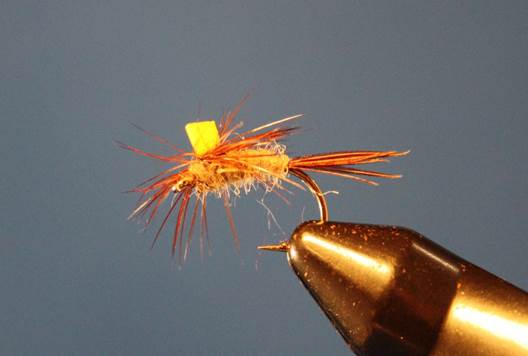
Hare's Ear Parachute Emerger
- Hook: TMC 2487, TMC 100, Dai Riki 125 Sizes: 12-20
- Thread: 8/0-12/0 Tan or Brown
- Tails: Pheasant Tail Fibers
- Abdomen: Dubbed, Light Hare's Ear Fur
- Wingpost: Dry Cell Foam
- Thorax: Dubbed, Dark Hare's Ear Fur
- Hackle: Brown, Dry Fly
One again by mixing and matching the colors and hook styles many mayflies can be imitated using this style of emerger.
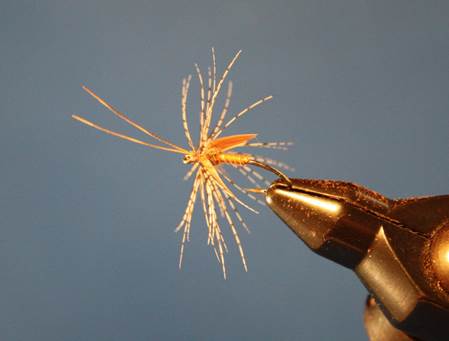
Hare's Ear Caddis Pupa
- Hook: TMC 2487, TMC 2457, Dai Riki 125, TMC 100, TMC 3969 Sizes: 10-20
- Thread: 6/0 to 1/12 Brown
- Abdomen: Dark Tan Turkey Biot or thinly dubbed Light Hare's Fur
- Thorax: Dark Hare's Mask Fur,
- Wingpads: Two or four Tips of Dark Tan Turkey Wing fibers, one set per side
- Hackle: Natural Hungarian Partridge Back Feather, Brownish
- Antennae: (Optional) Two Grizzly dyed Brown Hackle Stems
- Weight: (Optional) Beads or non-toxic lead fuse wire as desired
Remember this is only a prototype styles and many color combinations can be used to imitate the naturals you encounter on the water.
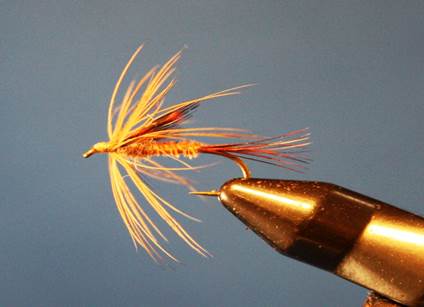
Tom's Wet Hare's Ear
- Hooks: Mustad 3906B, Mustad 3906, TMC 3769, TMC 100, TMC 2457, TMC 2487 Sizes: 10-20
- Thread: 6/0 to 12/0 Tan
- Tails: Brown Grizzly Hen Hackle Fibers
- Abdomen: Dark Tan Turkey Biot
- Thorax: Hare's Mask Fur, Dubbed
- Wings: Grizzly Hackle Tips, dyed Brown, one per side
- Hackle: Brownish-Dun Chukar Back Feather
Weighting is optional by I seldom use weight on my own wet imitations; if I want them deeper I can always add weight to the leader.
Enjoy & Good Fishin'
